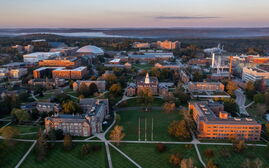
Processing Your Payment
Please do not leave this page until complete. This can take a few moments.
- News
-
Editions
View Digital Editions
Biweekly Issues
- May 13, 2024
- April 29, 2024
- April 15, 2024
- April 1, 2024
- March 18, 2024
- March 4, 2024
- February 19, 2024
- February 5, 2024
- January 22, 2024
- + More
Special Editions
- Lists
- Viewpoints
- HBJ Events
- Business Calendar
- Custom Content
As UConn’s 10-year, $1.5B NextGenCT initiative wraps up, school eyes additional investment in STEM facilities
 PHOTO | CONTRIBUTED
(From left) UConn’s Science 1 building in Storrs, Hartford campus and Werth residence hall in Storrs are some of the new projects that were funded through the university’s 10-year NextGenCT initiative.
PHOTO | CONTRIBUTED
(From left) UConn’s Science 1 building in Storrs, Hartford campus and Werth residence hall in Storrs are some of the new projects that were funded through the university’s 10-year NextGenCT initiative.
 Contributed
The Werth Residence Hall at UConn.
Contributed
The Werth Residence Hall at UConn.
 UConn's Hartford campus.
UConn's Hartford campus.
UConn’s 10-year, $1.5 billion Next Generation Connecticut (NextGenCT) initiative, which targeted investments in facilities, faculty and enrollment, was touted as “one of the most ambitious state investments in economic development, higher education and research in the nation.”
The program’s focus when state lawmakers and former Gov. Dannel P. Malloy originally approved it in 2013, was to help make UConn a top research institution in science, technology, engineering and math through new buildings, faculty and staff, and increased enrollment.
A decade later, the program has yielded some significant results, including major new campus facilities, increased research dollars and enrollment in STEM fields of study, and new faculty and industry partnerships that have spurred economic development across the state, officials said.
However, some shortfalls in initial funding expectations have hindered UConn’s ability to achieve some NextGenCT goals, particularly around faculty hires.

Even still, UConn and Democratic and Republican legislative leaders say the investment has been a success, helping to raise the stature of Connecticut’s flagship public university.
And more investment could be on the way. UConn has requested $420 million in additional capital funding from lawmakers for current and future STEM projects, which the school says would help address Connecticut’s current and future workforce shortages.
“If you value public education, you’ve got to support higher education institutions,” said Speaker of the House Matt Ritter, a Hartford Democrat who has been a big proponent of investment in UConn. “At the end of the day, tell me how we could have better directed those resources.”
By the numbers
NextGenCT was an extension of the UConn 2000 program that was launched in the 1990s and provided the school with billions of dollars in capital spending for campus renovation and expansion projects and other uses.
NextGen has been funded through both capital and operating budget components. In exchange for the funding, UConn was required by the legislature to track its progress in reaching certain benchmarks, including how it ranks nationally vs. other U.S. research universities.
UConn, which has more than 32,000 students across multiple campuses statewide, recently published a NextGenCT annual report that was shared with the school’s board of trustees in February. The report, dated December 2023, is significant because it highlights nearly a decade of progress since the 10-year program was first approved by the legislature.
It outlines key successes, including the construction of major new buildings on UConn’s Storrs and satellite campuses — many aimed at attracting STEM-focused students and faculty.
New buildings erected over the last decade included the:
- $220 million, 200,000-square-foot STEM Research Center and Science building in Storrs that came online during the current academic year.
- $139 million UConn Hartford campus, which includes 215,000 square feet of new space over three buildings, completed in 2017.
- $95.8 million Werth residence hall, with 730 beds and over 212,000 square feet, completed in 2016.
- $92.5 million Engineering and Science Building with 115,000 square feet, completed in 2017.
- $23.7 million Monteith mathematics building renovation, completed in 2016.
Enrollment boost
Another key focus area of NextGenCT was boosting enrollment.
According to the school, since fiscal year 2013, undergraduate enrollment in STEM fields has increased 41% at UConn’s Storrs campus and 61% at UConn’s regional campuses in Hartford, Stamford, Waterbury and Avery Point. The number of STEM-related undergraduate degrees awarded has increased by 28%.
Increased interest in UConn, which recently gained national attention for winning its second consecutive men’s college basketball championship, was reflected in the record number of applications the school received — 56,700 — for the Class of 2028.
“Although the number of high school graduates has decreased in the state and region, UConn is drawing an even larger component of that shrinking pie — without compromising on its high academic standards and admission requirements,” the annual report said.
At the graduate level, STEM enrollment since 2013 has increased by 30% in master’s programs and 26% in doctoral programs, UConn said. STEM-related master’s and doctoral degrees conferred have also increased by 16% and 34%, respectively, according to the university.
More UConn graduates are staying, living and working in Connecticut, and using their skills in key growth industries like biotechnology, engineering and health care, which is critical to growing the state’s economy, Ritter said.
Meantime, more than half of the engineers in Connecticut are UConn program graduates, according to state Sen. Kevin Kelly (R-Stratford), a former Senate minority leader and Higher Education Committee member who said the NextGenCT investment has been worth it.
Another key part of the program was establishing industry partnerships. The school said it has obtained $300 million in partnership funding from various new programs, many of which are located at the school’s new Innovation Partnership Building, a $132 million, 115,000-square-foot facility located in the UConn Tech Park.
Some of those partnerships include the $25 million UConn Thermo Fisher Scientific Center for Advanced Microscopy and Materials Analysis; $59.7 million Eversource Energy Center, focused on researching and mitigating storm hazards; $12.8 million Pratt & Whitney Additive Manufacturing Center; and $7.5 million Comcast Center of Excellence for Security Innovation, focused on cybersecurity.
The school has also worked on commercializing more of its research, a key focus area for major research universities. The number of companies that are in UConn’s Technology Incubation Program has grown from 29 in fiscal year 2013, to 59 in fiscal 2023, according to the school’s annual report.
TIP companies raised $146 million in capital in 2023 vs. $29.1 million in fiscal 2013.
Ritter said the NextGenCT price tag was large, but overall, he sees the investment as money well spent.
Going forward, he believes the success of the program will help support further capital projects.
“I’d like to see more kids admitted, see more dorms built,” Ritter said of UConn. “I think we can grow by a couple thousand students.”
Funding shortfalls
Despite those gains, UConn’s annual report does highlight challenges in achieving some NextGenCT goals.
For example, while the school continues to increase its annual research expenditures, the percentage change over the past five years has lagged other peer institutions.
UConn in fiscal year 2022 reported $367.6 million in research expenditures, which was a 52% increase from fiscal year 2013.
UConn’s peer institutions (including Michigan State, Purdue, Indiana and the universities of Utah, Georgia, Kentucky, Kansas and Delaware) experienced an average of 78% growth in research expenditures during that same time period.
Those peer institutions, on average, are also well ahead of UConn in other key research categories, like invention disclosures, patents issued, startup companies formed and licensing revenues.
Limited state operating funding support has also led to “significantly lower” faculty hires than originally planned, according to the annual report.
UConn has received the full $1.5 billion NextGen commitment through bonding, but additional annual operating funds were supposed to support the effort, particularly around faculty hires.
“But fiscal constraints at the state level have proven challenging,” university officials said, and only $15 million in operating support was provided during the first year of the program, with no additional operating funding provided in the remaining years.
“This reduction in operating funds is specifically a reduction in the capacity to hire new faculty, and it creates significant challenges for the University in meeting the operating goals of NextGenCT,” the annual report said.
UConn has funded 174 new NextGenCT faculty hires between fiscal 2014 and fiscal 2024, with 98 of those hires in STEM fields, the school said.
Full-time STEM faculty increased by 28% during that same time period to 857.
Kelly, the Republican lawmaker, said the operating funding shortfalls have been the result of state budget negotiations beyond UConn’s control.
“We should not equate the success of a program based on the number of professors hired, but more so on the students attracted and retained, then sent out into the workforce,” Kelly said.
What’s next?
UConn President Radenka Maric said initiatives like UConn 2000 and NextGenCT have made the university a top choice for students within Connecticut and throughout the U.S.

That’s reflected in the record number of student applications and national rankings, such as the U.S. News & World Report, which ranked UConn as the 26th best public university in the nation, and No. 58 overall.
However, she said more work still needs to be done to address Connecticut’s workforce challenges in key STEM fields, such as manufacturing, health care and life sciences, which face long-term shortages.
To address those needs, UConn has requested $420 million in additional capital funding for current and future STEM projects on its Storrs campus, including demolition of the 1960s-era Torrey Life Sciences Building, which would be replaced by a new $320 million, 200,000-square-foot science building.
The funding would also pay for $100 million in renovations to the school’s Gant Science complex.
The legislature’s Finance, Revenue, and Bonding Committee recently endorsed the funding request, Maric said, and it now awaits action in the House and Senate.


2022 Giving Guide
This special edition informs and connects businesses with nonprofit organizations that are aligned with what they care about. Each nonprofit profile provides a crisp snapshot of the organization’s mission, goals, area of service, giving and volunteer opportunities and board leadership.
Learn more
Subscribe
Hartford Business Journal provides the top coverage of news, trends, data, politics and personalities of the area’s business community. Get the news and information you need from the award-winning writers at HBJ. Don’t miss out - subscribe today.
Subscribe
2024 Book of Lists
Delivering Vital Marketplace Content and Context to Senior Decision Makers Throughout Greater Hartford and the State ... All Year Long!
Read Here-
2022 Giving Guide
This special edition informs and connects businesses with nonprofit organizations that are aligned with what they care about. Each nonprofit profile provides a crisp snapshot of the organization’s mission, goals, area of service, giving and volunteer opportunities and board leadership.
-
Subscribe
Hartford Business Journal provides the top coverage of news, trends, data, politics and personalities of the area’s business community. Get the news and information you need from the award-winning writers at HBJ. Don’t miss out - subscribe today.
-
2024 Book of Lists
Delivering Vital Marketplace Content and Context to Senior Decision Makers Throughout Greater Hartford and the State ... All Year Long!
ABOUT
ADVERTISE
NEW ENGLAND BUSINESS MEDIA SITES
No articles left
Get access now
In order to use this feature, we need some information from you. You can also login or register for a free account.
By clicking submit you are agreeing to our cookie usage and Privacy Policy
Already have an account? Login
Already have an account? Login
Want to create an account? Register
Get access now
In order to use this feature, we need some information from you. You can also login or register for a free account.
By clicking submit you are agreeing to our cookie usage and Privacy Policy
Already have an account? Login
Already have an account? Login
Want to create an account? Register










0 Comments